Excellence in the Arts, Media - by Jeff - September 14, 2008 - 19:16 Etc/GMT+5 - 1 Comment
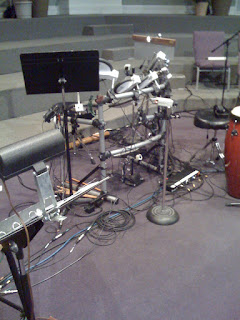
We recently cleared and reset the stage at High Pointe and were surprised how long it took us to get everything hooked up and running. We have done a lot to simplify cabling and keep the look cleaner, but there is an incredible amount of connections that need to be made after everything is set in place. Is there a quicker and easier way?
 While we don’t clear the stage often, every once in a while we do for an event and use it as an excuse to clean up and re-lay-out our setup. I would like to make a habit of removing everything that isn’t used every service and keep the platform clear of any unnecessary clutter. This would include clearing the stage almost completely once a month for our 1st Sunday pm service. But to do this we need to figure out a way to not spend 4 hours resetting the stage for the following Sunday morning service.
While we don’t clear the stage often, every once in a while we do for an event and use it as an excuse to clean up and re-lay-out our setup. I would like to make a habit of removing everything that isn’t used every service and keep the platform clear of any unnecessary clutter. This would include clearing the stage almost completely once a month for our 1st Sunday pm service. But to do this we need to figure out a way to not spend 4 hours resetting the stage for the following Sunday morning service.
To date we have been simplifying our setup where possible, but there is still so much! We have gone to using sub-snakes for each group of vocalist and instruments to avoid running long cables. We now how baskets full of 25, 35 and 50 foot cables, but run out of the short 6 and 10 foot cables. We have labeled the snakes with the instrument or vocal they are used with to speed up connections and troubleshooting. We use clamps and brackets to minimize the number of stands used on the stage. But there is still a lot to hook up. We have 30 channels of instrument inputs, 18 channels of vocal mics, 6 channels of wireless, all in use almost every Sunday Morning. Add to that the 7 monitor wedge mixes and 7 IEM mixes going back out onto stage (all from a 40 input / 8 output mixer, but that is a different story) the power requirements, music stands and lights (with their dimmers) and there are many many cables to keep straight and connected.
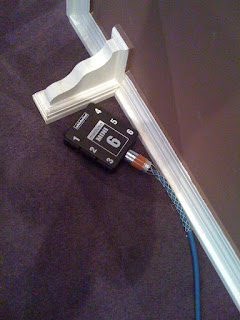
What else can be done to speed up setup / teardown and keep the platform looking neat and organized? We have to keep the flexiblity for easy changes. One thought is to build some power distribution cables with outlets spaced every 3-4 ft down the cable to clean up the extension cords.
 What other ideas do you have? Have you seen something work well elsewhere? For those who are not from High Pointe, what do y’all do to keep your setups quick? Those of you who saw the new stage setup this weekend, any thoughts or comments?
What other ideas do you have? Have you seen something work well elsewhere? For those who are not from High Pointe, what do y’all do to keep your setups quick? Those of you who saw the new stage setup this weekend, any thoughts or comments?
family, Technology - by Jeff - September 9, 2008 - 02:03 Etc/GMT+5 - Be first to Comment!
had a very interesting experience today. I purchased my kids an inexpensive dell laptop (used) about a year ago and have regretted it ever since. This laptop was such a dog – slow, unresponsive and impossible to use if you had more than one program running. I tried everything – wipe the drive, install xp straight up (no manuf. junk), hardware test, etc, etc. This should be an okay computer – 1.5GHz mobile celeron (yea, I know, but cheap), 1gb memory, 256mb dedicated graphics, 80gb harddrive, but it never worked well enough to be very usable.
 Then the power supply died. yup, that little brick of a powersupply. So the laptop sat around for a couple of months…. I decided I would sell it and see if I could get any of the cash I put in it back out…. but I wanted to make sure it just needed a new power supply – so, I grabed a power supply off a HP laptop we have at church…. simular specs, simular plug…. wow, all of a sudden this computer actually works! I can even draw in Sketchup while I run an anti-virus scan. Could it have had a bad power supply all along?
Then the power supply died. yup, that little brick of a powersupply. So the laptop sat around for a couple of months…. I decided I would sell it and see if I could get any of the cash I put in it back out…. but I wanted to make sure it just needed a new power supply – so, I grabed a power supply off a HP laptop we have at church…. simular specs, simular plug…. wow, all of a sudden this computer actually works! I can even draw in Sketchup while I run an anti-virus scan. Could it have had a bad power supply all along?
family, Media - by Jeff - September 2, 2008 - 19:37 Etc/GMT+5 - 2 Comments
Some of you might be wondering if this has just turned into a blog about what worked and what didn’t for our Sunday services – Hopefully not. I have had a lot of good intentions about blogging ideas here, and the weekly Foldback article should just be one of many blog post, but, as with many of you, I have been extremely busy lately. So I have several partial blog post started, that I might remember my ideas later, but no time to finish.
 So what has me so busy? I have been having a lot of fun lately. As many of your know I am on staff at High Pointe Baptist Church full time, and the media ministry is always growing and expanding, requiring care and feeding. But above and beyond of that I am also a Church Media Consultant for other churches and companies, and lately that has also been a full time job. In the midst of they two full time jobs, I have also started making a more purposeful effort to be a better dad and husband and make good quality time for my family.
So what has me so busy? I have been having a lot of fun lately. As many of your know I am on staff at High Pointe Baptist Church full time, and the media ministry is always growing and expanding, requiring care and feeding. But above and beyond of that I am also a Church Media Consultant for other churches and companies, and lately that has also been a full time job. In the midst of they two full time jobs, I have also started making a more purposeful effort to be a better dad and husband and make good quality time for my family.
 The family requires a lot of direction and planning, and my wife does a great job of helping hold everything together, getting kids to their appointments and practices on time, making sure we are all fed and clothed and general managing a large family, and I am very grateful for all she does. I won’t go into great detail about all that is going on there, as she also manages to keep her blog and facebook page well updated with all that is going on, and I would just be repeating a lot of what she has already said. But let’s say between school, football, soccer, scouts, youth, media, orthodontics, dentist, doctors, etc, etc, etc, we have been running all the time. And let’s not even talk about our remodeling projects!
The family requires a lot of direction and planning, and my wife does a great job of helping hold everything together, getting kids to their appointments and practices on time, making sure we are all fed and clothed and general managing a large family, and I am very grateful for all she does. I won’t go into great detail about all that is going on there, as she also manages to keep her blog and facebook page well updated with all that is going on, and I would just be repeating a lot of what she has already said. But let’s say between school, football, soccer, scouts, youth, media, orthodontics, dentist, doctors, etc, etc, etc, we have been running all the time. And let’s not even talk about our remodeling projects!
 On the consultant side of things I have been working on several really cool projects and several other projects are in the wings. We just finished helping The Father’s House in Vacaville CA with a new speaker system based around JBL line arrays and Bag End subs. This church knows how to ROCK and the system performed showcases their sound extremely well. Currently I am working on audio system design for 3 rooms in a childrens space expansion at a church in Kansas City (and these rooms have more AVL (audio / video / lighting) than many churches!) I am also picking back up a project that’s been on hold for a while in Oak Harbor, WA, reviewing and finishing the design work for audio and acoustics in their sanctuary and youth dome.
On the consultant side of things I have been working on several really cool projects and several other projects are in the wings. We just finished helping The Father’s House in Vacaville CA with a new speaker system based around JBL line arrays and Bag End subs. This church knows how to ROCK and the system performed showcases their sound extremely well. Currently I am working on audio system design for 3 rooms in a childrens space expansion at a church in Kansas City (and these rooms have more AVL (audio / video / lighting) than many churches!) I am also picking back up a project that’s been on hold for a while in Oak Harbor, WA, reviewing and finishing the design work for audio and acoustics in their sanctuary and youth dome.
 Then there is the ever growing list of media work at High Pointe. Last month our focus was on lighting in the Sanctuary and we were able to do many, but not all the repairs and mantainence needed in there. This month our focus is re-vamping the Livingston Training Room Audio and Lighting, and preparing the other training rooms for overflow and presentation needs.
Then there is the ever growing list of media work at High Pointe. Last month our focus was on lighting in the Sanctuary and we were able to do many, but not all the repairs and mantainence needed in there. This month our focus is re-vamping the Livingston Training Room Audio and Lighting, and preparing the other training rooms for overflow and presentation needs.
So there is my excuse….. but I will try to be a little more faithful in getting other blog post and updates worked in here.
Cool Products, Technology - by Jeff - August 4, 2008 - 03:43 Etc/GMT+5 - Be first to Comment!
Just a quick post – a couple very helpful and useful tools.
Need to take and organize notes? Several different people all suggested Evernote to me recently, so I signed up and wow, I really like it – very handy. It is software / webware / pdaware enabled and seems to go a great job keeping everything in sync!
And love drawing and organizing in Visio but can’t afford it? Check out Dia (sorry, not available for mac at this time….. still looking for a free alternative)
thank you to all who passed along these great programs to me!
family, Life - by Jeff - August 2, 2008 - 11:14 Etc/GMT+5 - Be first to Comment!
Yes, I am still here, still going to post. It has been a busy few weeks.
Last weekend my family and I headed to Memphis for my wife’s 20th year class reunion. The children had a great time with their grandparents, and Amy and I had too much fun enjoying time together and with her old class mates – but that’s another story! Then I headed to WorshipGod08….
I do what to praise God for this past week though. A lot has gone on, and I have seen Him work in some awesome ways. A little background. Pastor Juan had suggested that we, the staff leadership should attend this conference together back some time ago. We had made our reservations and our wonderful travel planner had booked our flights. I was excited as this was to be the first time we as a staff had gone together to any of these conferences and knew it was going to be an awesome time.
It was only after the plane tickets had been booked that I found out we would be flying thru Memphis on the way to Gaithersburg, MD…. yes, Memphis, where my wife’s class reunion would be taking place. Well, that seems awful silly of me to drive back to Austin on a Monday so I could fly back to Memphis (on the way to Maryland) on Tuesday….. why don’t I just plan on catching up with them at the Memphis airport on Tuesday and let my family stay in Memphis for the week? Great Idea…. or at least I thought so.
I tried to change my ticket, but it was going to cost $450, almost twice the price of the original ticket. So after talking to a few people I decided I would check in on line for my flight, “miss” my flight from Austin, and “catch up” in Memphis…. after all, the airlines I usally fly always seemed to help me get to my final destination, right? BAD IDEA. First, this wasn’t the airlines I usally fly. Second, well, read on.
I check in online Tuesday AM, and I notice a little disclaimer at the bottom of the page saying if you don’t notify the airlines before the missing the first leg of your flight the travel ticket is null and void….. so I call the airline to let them know what I am going to do, and am told I can’t do that. I am told that my ticket will be cancelled if I do, and it is going to cost me $1680 to change my ticket. Thanks, but no thanks. So I start praying. I know I am suppose to be there. We have others start praying. I know I need to try everything I can. So Amy takes me to the airport (memphis) – sure enought, I don’t have a reservation anymore (the plane had already left Austin at this point, Matt tells me later they came on the plane right before shutting the door asking if Jeffrey Jones was anywhere on the plane….) BUT, what’s this? I can still check my luggage? Okay, I wasn’t planning on it, but yes, one bag to Baltimore!
So I go thru secuity (yes, I had my boarding pass that I had printed earlier, yes they questioned me about being there before my flight had arrived…) and go back to the gate. I ask the gate agent to check my seat assignment while I prayed furvently. No sir, you are not listed in that seat….. infact sir, you are not listed in any seat…. here let me take care of that for you…. Praise you Jesus!
Now I admit, I was nervous as anything till the plane took off from Memphis, but I did meet up with the pastors and we got on the plane and left on time. So I made it….. BUT.
Brenda, who arranges our travel (THANKYOU!) called to confirm my return trip, and sure enough, my ticket was cancelled. The airlines said there was NO WAY I should have been allowed on the flight there, and there was NO WAY I would be allowed on the flights home. I started thinking about what I was going to do on my extended stay in D.C…… But Brenda was able to work out a return trip for me after begging and pleading with the suppervisors at the airlines, who assured her this was the ONLY exception they have or will EVER make, they reinstaited my ticket for only a $100 change fee. PRAISE GOD.
Meantime it has been an AWESOME conference, I will post more about that later.
Cool Products - by Jeff - July 10, 2008 - 20:39 Etc/GMT+5 - 5 Comments
I switched to a MacBook Pro about 18 months ago and love it. I often have people tell me there is no way they could switch because not enough software is available for the Mac. I also have other people ask me what software I use. So here is a quick rundown of what I have on my mac that I use on a regular basis:
VERY COOL password vault for mac (been using it for over a year): 1Password – http://agilewebsolutions.com/products/1Password
Google sketchup is available for mac: http://sketchup.google.com
Quickbooks is available for mac (been using it for a while now for tracking my business expenses and invoicing): http://quickbooks.intuit.com/
I switched to photoshop CS3 on mac: adobe.com
instead of illustrator, I use inkscape : http://www.inkscape.org/ (free)
A cheap package of photo tools: http://www.yellowmug.com/bundle/
If you don’t use TIMEMACHINE (bundled with OS X) START! This am Amy’s email was GONE…. figured out which file, popped open time machine, went to 11:00 last night and restored that file. VERY COOL, and makes me feel a lot better about traveling with my laptop.
For ripping DVDs and dumping them to my apple TV or iPod, I use Mac the Ripper and HANDBRAKE (http://handbrake.fr/ and http://www.mactheripper.org/ )
I have ffmpegx to do most of my media file transcoding
OnyX is a requirement to keep the system running smoothly: http://www.macupdate.com/info.php/id/11582
If you want to make your mac more secure and better manage your firewall, check our waterroof: http://www.hanynet.com/waterroof/
Then there are all the great apple apps: iWork08 suite, iPhoto, iWeb, mail, Safari, iTunes, Final Cut Studio, etc.
That is probably the majority of “extras” I am currently using. Of course I have a gazzillion other things installed, probably why my machine can get SO SLOW at times…. still better than my windoze machine.
there are a few applications I want to add soon – to keep me out of windows even more:
the cad solution I am thinking about switching to: vectorworks (http://www.nemetschek.net)
the visio “like” software for mac (free trial): OmniGraph (http://www.omnigroup.com/applications/omnigraffle/)
Media - by Jeff - June 30, 2008 - 16:41 Etc/GMT+5 - 1 Comment
[this is part 1 of a 2 part article, please see “How much for a projector?“ for part 2,]
Why should we use projectors in Worship?
Projectors are only a tool to allow a larger crowd of people to view text, a computer image or even video. A small screen like an iPod is great for personal viewing, a television might work for the entire family, but when 700 believers gather in one room, a projector and screen are the most practical way to share visual media. The projected image is a focal point, a visual stimuli, a reinforcement tool for memorization, and a distance breaker in larger assemblies.
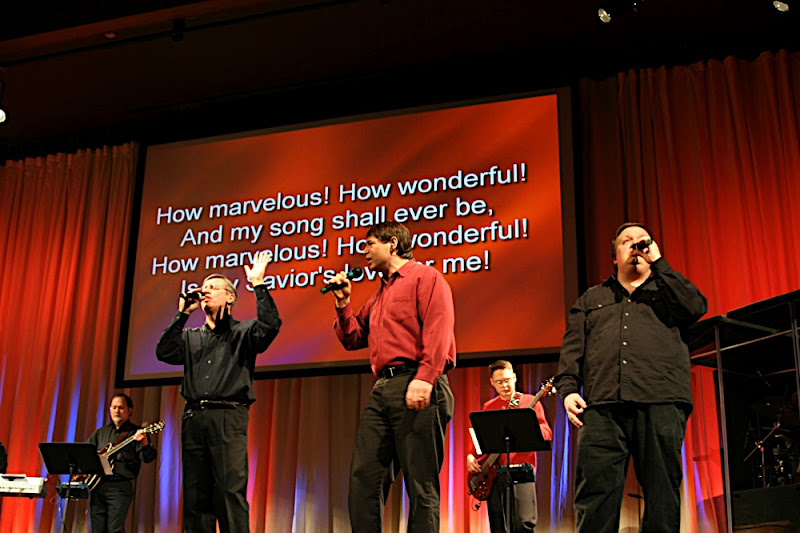
Words on a large screen at the front of the room will focus attention in one direction, praising and worshiping together. Printed song-sheets cause individuals to sing downward, focused on the page in front of them. With a screen up front, all are on the same page, instead of flipping pages in a song book. Projection is also fabulous for displaying a Scripture for all to read as one. By projecting sermon notes, points can be revealed one at at time keeping each listener focused on what is being said and eliminating the distraction of the entire sermon outline in a bulletin insert.
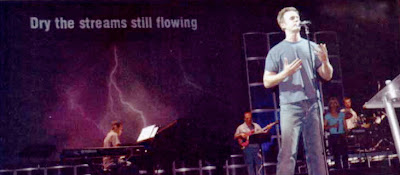
Having created a focal point, projection can then deliver images, colors and textures that help steer corporate worship, creating an atmosphere that brings all the senses to attention to worship in unity. Not unlike stained glass windows and frescos in cathedrals of old, projected images can inspire us to worship God together for who He is and for what He’s done and created. Images can be used to capture the heart and bring conviction and call the viewer to action. Finally- one potential distraction to corporate worship are announcements and testimonies that become so wordy as to lose attention: having these prerecorded and shared via projection can be much more effective at keeping the worship atmosphere through the benediction.
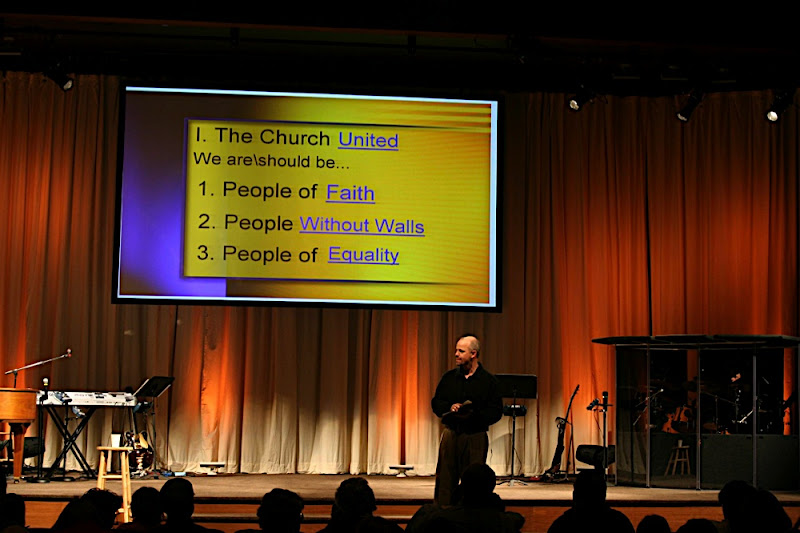
Reinforcement of ideas through stories and illustrations is a technique that goes back to prophets of old. Repetition of important points works, and is even better when a theme is repeated. We see this in Scripture, and we see it in today’s media culture. When various media work to communicate the same message, the message becomes memorable, easier to understand. Seeing the same logo on banners, on the screen and on the printed bulletin, all while hearing the message, increases retention of the topic and the text. For example, a busy, overwhelmed mom sits through one worship service that uses limited media, and realizes by dinnertime Sunday that she cannot remember the text of the sermon. Another day, she comes across a sermon on the Internet where the preacher has visual aids- in the form of projecting a graphic that matches a stage prop and the print on the virtual “bulletin” (which had been the bulletin given out at that church’s Sunday Morning service). The complete saturation into her consciousness through not only auditory memory but also visual memory means that six months later, the sermon is remembered- not only the topic, but details of the teaching.
 Projection is the means to share a message with a larger audience. Communication is largely unspoken communication such as gestures and facial expressions. Image Magnification (IMAG) allows the large congregation see the details of the pastors’ and speakers’ communication, and improving the transfer of the message. Likewise, cameras can be turned to the audience improving the preacher’s view of his listeners. This enables him to become even more effective, responding to the feedback he’s receiving. Without projection in a large assembly, some may feel they are on the fringe. Projection draws everyone nearer, facilitating intimacy in even a large gathering.
Projection is the means to share a message with a larger audience. Communication is largely unspoken communication such as gestures and facial expressions. Image Magnification (IMAG) allows the large congregation see the details of the pastors’ and speakers’ communication, and improving the transfer of the message. Likewise, cameras can be turned to the audience improving the preacher’s view of his listeners. This enables him to become even more effective, responding to the feedback he’s receiving. Without projection in a large assembly, some may feel they are on the fringe. Projection draws everyone nearer, facilitating intimacy in even a large gathering.
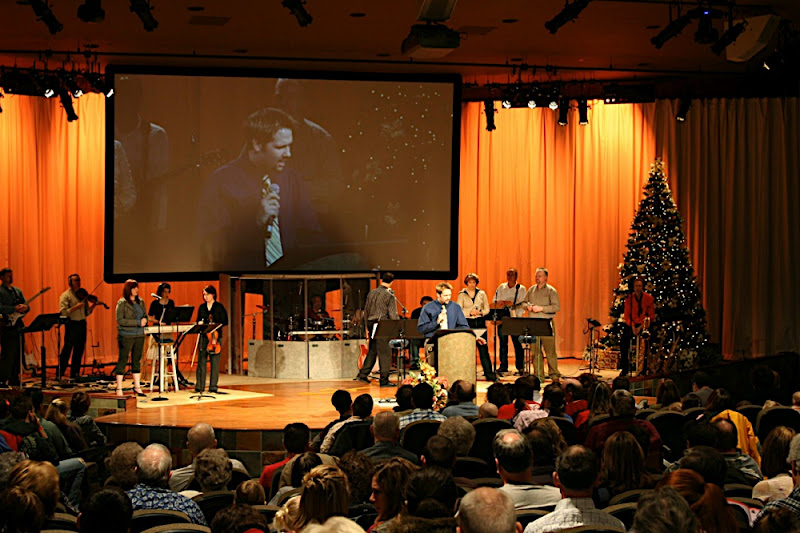
Video should be a support tool used in our corporate worship. As with the room itself, air-conditioning, lighting: it can be taken for granted as it helps a group of believers worship as a single body, helps deliver the message, helps set the mood and atmosphere. Video helps engage more of our senses and focus our mind on what we are hearing and experiencing. Video can help make a larger gathering more intimate, allowing those all around the room see and experience the same thing as those up close to the platform. Video is a communication tool that can be used to help convey the preaching, help inform the congregation of news, events and needs, help share personal testimonies and encourage and build up the body. Projection is the tool that makes this possible.

Technology - by Jeff - June 24, 2008 - 04:39 Etc/GMT+5 - Be first to Comment!
With the failure of the primary video projector during service this week, now is a good time to re-examine the practical aspects of how to choose a projector.
Why do we need such an expense as a projector?
When choosing an appropriate projection system one must consider the needs to be met and choose the components to satisfy those requirements. Light, room and screen size, and resolution are the variables to be considered.
The lighting conditions in the space will determine how bright the projection image must be to be seen clearly and with proper colors and definition. Just as the light from the projector reflects off the screen so one can see an image, the light in the room also is reflecting off the screen (usually WHITE light), competing in brightness with the image. Add to this a fundamental problem with projection – with dark areas of the video or image, you are trying to make a WHITE screen surface appear BLACK! Luckily, eyes have a limited range of sense from the brightest area of an image to the darkest area, so all we have to do is make what is suppose to be white or bright much brighter than the areas that are suppose to be dark or black. How bright of a projector that is required to do this depends on how much room light is reflecting off the screen causing the darker areas to be light. A movie theater is relatively dark, so it doesn’t take a real powerful projector to make the bright areas much brighter than the dark areas. A sanctuary and platform with lots of bright lights, however, requires a bright powerful projector to produce an image.
The size of the screen also determines how big a projector is needed. A finite amount of light comes out of the lens of the projector (measured in Lumens) and begins to spread. The farther the screen from the projector, the more the light has spread out and the larger the image. The problem is that finite amount of light is spread out over a larger and larger surface area, thus the amount of light reflecting back from any one area of the image is less and less. This is why a larger screen requires a more powerful projector than a small screen.
The viewing environment and use of the screen determines the size of the screen. A screen for a movie needs to be big enough to envelop the audience, to transport them into the movie and help them forget they are sitting in a theater with a couple hundred other people. A screen for a presentation needs to be large enough that the people sitting farthest from the screen can see and understand the images being shown. A screen for displaying lyrics and scriptures needs to be large enough that six to eight lines of text easily fit and can be read from the back of the room. Studies have shown that the optimal height of the screen should be 1/6th to 1/8th the distance to the last row of seats. For a sanctuary where the last row of seats is 120 feet away, this translates to a screen that is 15 to 20 feet tall. But don’t forget the front row, if the screen is too big they will not be able to view the entire screen from edge to edge, so the distance to the back row should be balanced with the distance to the front row, or more than one screen should be used, each covering different viewing areas. The width of the first row also effects the screen size and placement choices. As with many other things technical, tradeoffs need to be balanced in choosing the screen size.
How close the congregation is to the screen determines the need for resolution of the image. The closer people are to the screen, the more likely they will be able to see the individual pixels that make up the image. The larger the projected image is, the larger these pixel blocks are. Seeing individual pixels causes images and text to look jagged and grainy. With projection and other digital images there is also the “screen door” effect, where the black lines between individual pixels break up the image. When combined with motion video, this causes annoying artifacts for some, while other people are so sensitive to it as to feel motion sick – not the best atmosphere for worship. Those who study such things and set standards have determined the required resolution versus seating distances, based upon the human eye’s ability to discern the height of an image at a given distance. These standards can be applied to select the required resolution for the projection system.
Why won’t a consumer, portable projector work?
There are advertisements from the popular computer manufacturer or office supply house for inexpensive projectors that seem very bright. It is tempting to think that a thousand dollar projector will serve the congregation instead of spending tens of thousand dollars on a large venue projector, but that is seldom a satisfactory solution. There are some big differences between the consumer grade projector and the venue grade projector.
Large venue projectors can accept a wide range of lenses, so the proper lens can be chosen based upon the screen size and the best location to mount the projector. Portable projectors have a built in lens, which has a limited zoom range, limiting the distance from the screen these can be mounted. Because these projectors are often designed to be set up in conference rooms and class rooms front and center, the zoom range of the lens is designed to set the projector close to the screen – often impractical in a church sanctuary that holds more than 200 people (the typical size of a conference or class room).
Larger projectors are often designed for quiet and continuous operation, while portable projectors of often designed to be small and light weight. The consumer, portable projector uses noisy cooling fans to move a lot of air to keep them cool enough for short term use, but may overheat easier during long periods of operation.
Large venue projectors start at 4000 – 5000 lumens and are available up to 30,000 lumens plus, where as portable projectors typically are only available up to 3000 – 5000 lumens of brightness. As we have seen above, sanctuaries and worship centers often require much brighter projectors than a home theater or conference room, with the typical large screen requiring 10,000 to 12,000 lumens, much brighter than most portable projectors can provide.
There are many other specifications and room design factors that can help determine the right projector for the job, beyond the scope of this article, but the intent here is to give an overview of projection and the practical aspects of implementing it in a house of worship. For more information about projection systems, contact a church media consultant such as myself (jeff@essentricaudio.com) or let me suggest a design build firm such as Stark Raving Solution and let us design the right projection system.
Excellence in the Arts, family, thinking green - by Jeff - June 17, 2008 - 00:26 Etc/GMT+5 - Be first to Comment!
It’s been a while since I posted, a lot has been going on, so here is a brief rundown.
First of all, Vacation! Yes, my family and I actually took some vacation, and I really did take off a few days – that’s right, several days without ANY work! Now to be honest, we were gone 10 days, and I did work part of at least 5 of them. So what did we do? Our youngest 4 went to have a vacation with my parents in the Houston area, then Amy, our oldest 3 boys and myself took off on a road trip and camping.
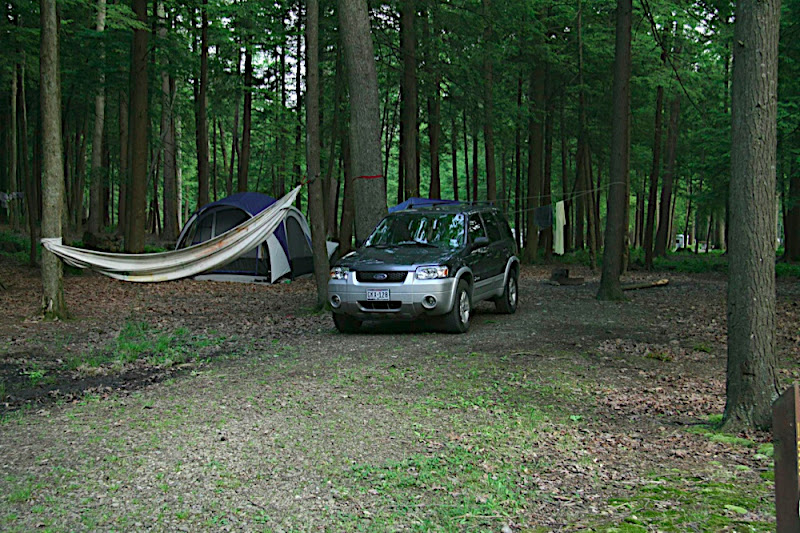
We challenged ourselves to do this trip for as little cost as possible, so we pushed every mile per gallon we could out of our little hybrid Escape, avoided eating out as much as possible, camped or stayed with friends and family and had a fun time doing it. A big thank you shout out to all of Amy’s e-maginary friends that hosted us on the road and helped us with supplies and food camping (sorry, you just can’t fit that much food in that tiny SUV when you have 5 people and their stuff in there too!) A big thank you to our media team and church staff who covered all the happenings at church while we were gone also!
So where did we go? Photos and Google map are here: but the short of it is DC and then camping in NW Pennsylvania. We had a wonderful time but we are also glad to be home.

Planning Retreat – Yep, while I was sitting on a stump out in middle of a forest, spent a good part of a day and a half praying to reading scripture, listening to teachings and sermons and firing up the apple laptop and writing out a ministry plan for the media ministry for the 2008 / 2009 planning year. More details will be posted as we start to work thru the plan, but you can rest assured that we really do have a plan in place!

Consulting – it seems like when it rains, it pours. Right now we have a half dozen clients whose projects are in full swing and need design work done NOW. So I am in middle of several designs, working with the clients to meet their timelines and needs, all of which is keeping us very busy. With some careful planning and scheduling, it looks like we will be able to get everything done for everyone, but it is looking like a busy summer.
Foldback - by Jeff - May 19, 2008 - 17:33 Etc/GMT+5 - Be first to Comment!
Okay, so I jumped in and never really explained what “Foldback” is or what I am doing with it here.
First, a quick bit of history. Back in the dark ages of audio reinforcement, one of the cheapest audio consoles (mixing boards) that was available was the Yamaha MC series. Several churches I worked with back then had these consoles (8, 12 or 16 channels), so I was fairly familiar with them. Yamaha used the term Foldback for the stage monitor sends, but very few other manufactures use that terminology. The idea is that you are folding back some of the audio from the musicians back to them so they can hear what they are doing.
So the idea of my “foldback” for my blog is to fold back some comments, observations and planning information to those who served on the media team for the weekend that we might all grow in excellence in our service of worship. All this to further our purpose to glorify Christ, help spread the gospel and provide tools of training and encouragement for the church.
While we don’t clear the stage often, every once in a while we do for an event and use it as an excuse to clean up and re-lay-out our setup. I would like to make a habit of removing everything that isn’t used every service and keep the platform clear of any unnecessary clutter. This would include clearing the stage almost completely once a month for our 1st Sunday pm service. But to do this we need to figure out a way to not spend 4 hours resetting the stage for the following Sunday morning service.
What other ideas do you have? Have you seen something work well elsewhere? For those who are not from High Pointe, what do y’all do to keep your setups quick? Those of you who saw the new stage setup this weekend, any thoughts or comments?






















